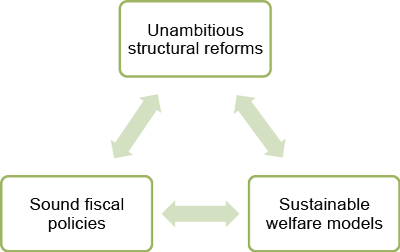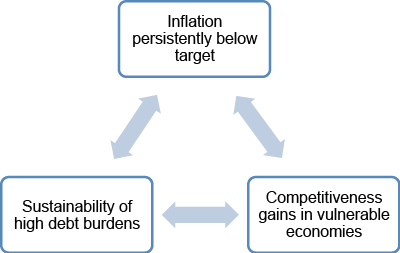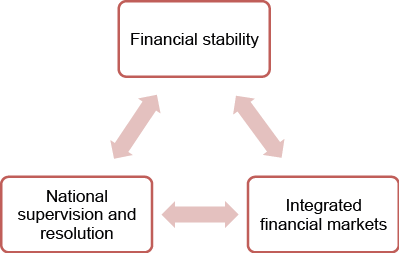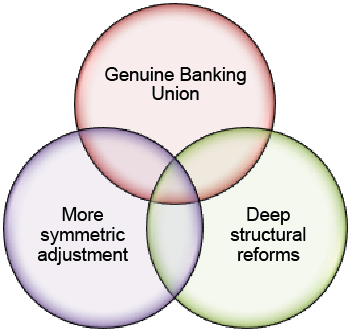While it would be premature to declare victory, owing to sustained policy efforts at all institutional levels, major progress has been made in the past two years that has put Economic and Monetary Union (EMU) on much firmer ground. All strands of economic policymaking have been working together to overhaul economic governance, to ensure the efficient transmission of monetary policy, and to create effective financial firewalls. What made this possible was the clear political determination to safeguard the integrity and future of EMU.
We have, however, not yet reached a steady state in which EMU’s architecture can be considered complete and all economic challenges solved. There is still a risk that a new steady state will be characterised by economic stagnation and persistently high unemployment. Unless appropriate macroeconomic policy conditions are secured and ambitious reforms implemented, a slow, uneven and fragile recovery may become the central scenario. The Eurozone faces a number of concrete policy challenges, the responses to which will shape the Eurozone’s ability to withstand future crises and asymmetric shocks. In this column, I explore three fundamental challenges that are open to a range of policy responses, some more EMU-friendly, others less so. Choosing the former kind of response is vital to underpin confidence and, hence, put the current recovery on a sustainable basis.
Economic and policy challenges: Post-crisis ‘inconsistent trinities’
Three central challenges will act as a real-life test of EMU’s coherence in the coming years, and these can be represented as three ‘inconsistent trinities’, or trilemmas for the Eurozone. For each of these trilemmas there appears to be an optimal, EMU-friendly solution; deviations from this optimal solution would imply trading-off indispensable policy objectives against each other.
Structural reforms to safeguard European welfare systems
In the current slow growth environment and given ubiquitous high debt levels, there is little choice other than to maintain a prudent fiscal stance, though with stronger differentiation among member states according to their fiscal space. Slow growth also makes unemployment more persistent, thereby raising the spectre of depreciating human capital, as well as social unrest at a juncture where the European social model is increasingly under strain. There are considerable equity implications of the ongoing adjustment and reform process that demand a rethink of Europe's welfare systems accordingly.
- A first inconsistent trinity, therefore, exists between conducting sound fiscal policies and achieving sustainable welfare systems while pursuing unambitious structural reforms that will keep EU economies locked in a ‘stagnation trap’.
It is not possible to have fiscal discipline and at the same time maintain the European welfare model on a sustainable basis without structural reforms that are able to deliver job creation and generate growth in order to finance those welfare models. At the same time, if fiscal discipline is to be maintained without embarking on far-reaching structural reforms to increase growth, this will only come at the expense of dismantling, or at least gradually eroding the European welfare model.
Since our welfare model is a central safeguard of social cohesion, failure to seize reform opportunities will, by extension, risk undermining an important element of the inclusive European social market economy. Besides, social cohesion is a pre-condition for political viability of more integration. Therefore, ambitious structural reforms are the EMU-friendly resolution of this trilemma.
Figure 1 First inconsistent trinity: Political and social viability
An ambitious agenda of structural reforms should be pursued with policies focusing on competitiveness gains within sustainable and inclusive growth models. Balanced growth will require an acceleration of reforms in the core and semi-core countries, not only in the vulnerable countries which have shown greater ‘reform responsiveness’.
Reclaiming macroeconomic policy space for greater adjustment symmetry
The Eurozone faces a fundamental challenge to support the nascent recovery and deal with macroeconomic vulnerabilities. Modest real growth – partly resulting from ongoing and inevitable adjustment in private sector balance sheets after such a major financial crisis – will be compounded in its effect on nominal GDP growth by slowing Eurozone inflation, which is forecast at around 1.5% for 2014 and 2015.1 Slow nominal GDP growth becomes a particular concern when economies have to deal with a large debt overhang, as is currently the case for many parts of the Eurozone.
Besides ensuring debt sustainability in a low-inflation environment, Eurozone members face a simultaneous challenge in ensuring a rebalancing of competitiveness and external accounts. In the absence of nominal exchange rate adjustment, meeting these challenges can only be achieved via changes in relative prices across the Eurozone. Restoring competitiveness in vulnerable economies will generally require a negative inflation differential with respect to surplus countries located in the Eurozone core, so as to ensure that price levels in the periphery rise more slowly than in the core.
The objectives of debt sustainability and external rebalancing in the Eurozone may conflict, as long as actual Eurozone inflation remains persistently low – well below the 2% inflation target of the ECB. This is because competitiveness rebalancing for the periphery would dictate much lower inflation rates, or even outright negative inflation. This would adversely affect debt dynamics in the periphery and would create a deflationary bias in the Eurozone as a whole. This conflict is particularly acute for highly indebted countries in the Eurozone, which tend to have greater competitiveness adjustment needs, notwithstanding their progress made to date (Pisani-Ferry 2012).
- This conflict of policy objectives and economic realities can be represented as a second inconsistent trinity – that vulnerable countries cannot simultaneously reduce their high debt burdens and gain competitiveness in an environment of persistently low Eurozone average inflation.
Figure 2 Second inconsistent trinity: Adjustment objectives in the Eurozone
As both debt sustainability and competitive rebalancing lie at the very heart of macroeconomic stability in the Eurozone, the EMU-friendly resolution of this trilemma, therefore, is to reject inflation being persistently below ECB target. Doing so would widen the range of possible inflation differentials between the core and periphery that would still ensure non-deflation in the periphery.
Crucially, this is not to argue for a change in the ECB’s inflation target, but rather to argue in favour of the ECB’s continued efforts to meet its mandated target. Besides risking dislodging well-anchored inflation expectations, persistently low inflation may bring the Eurozone close to a Japanese-style nominal depression, the costs of which have become all too evident during Japan’s ‘lost decade’. But stemming the disinflationary momentum in the Eurozone cannot be done by the ECB alone, though making full use of both conventional and unconventional tools can contribute to this goal.
Instead, ensuring different inflation rates in a diverse economic region consistent with aggregate price stability such as the Eurozone is also about ensuring appropriate demand conditions in both the core and periphery. Tremendous reform efforts are already underway in vulnerable countries at a particularly weak point in the business cycle. Part of a durable resolution of this trilemma will also involve core countries undertaking reforms to boost domestic sources of growth resulting in higher domestic demand, in particular by supporting public and private investment. This balanced approach to Eurozone macroeconomic policy may also be thought of as a more symmetric form of adjustment that would make tackling the main vulnerabilities in the Eurozone less onerous to deliver.
Effectively combatting systemic financial sector vulnerabilities
The third challenge, closely connected with the two previous ones, relates to the Eurozone’s highly integrated financial system in the context of large banking sector vulnerabilities and limited national fiscal space.
Many banking systems are both fragile and too large for any sovereign state to comfortably backstop. This is the root of what has been termed the ‘deadly embrace’ between banks and their sovereigns (De Grauwe 2013). A related problem has been the fragmentation of the Eurozone’s financial systems. Credit conditions have become highly divergent across the Eurozone, thus constraining recovery, especially in the more vulnerable economies, and impairing monetary transmission channels.
- This policy challenge represents another inconsistent trinity, relating to the fact that financial stability and integrated financial markets cannot be achieved unless the deadly embrace between the banks and the sovereigns is broken (Obstfeld 2013).
Pisani-Ferry (2012) develops a related trilemma, which elucidates the role of the ECB’s lender of last resort function in a ‘deadly embrace’ context without common fiscal backstops for banks.
Figure 3 Third inconsistent trinity: Restoring financial integration and stability
This trilemma suggests that the aims of achieving financial stability within an integrated, competitive, and dynamic single financial market can only be satisfied by allowing for greater mutual responsibility for banking sector problems. This provides an intellectual underpinning to a genuine banking union, which has been developed and implemented since 2012. While several initiatives have been taken on the regulatory front, completing a full banking union with a mutual backstop remains a clear priority.
Overcoming the policy conflicts
The current economic and political realities suggest a need for policymakers to reflect on a new paradigm for economic integration in Europe. Resolving the three aforementioned inconsistent trinities through EMU-friendly solutions can achieve a superior outcome that benefits all Eurozone members. These respective solutions form yet another trinity, which this time is consistent and self-reinforcing.
Figure 4 A consistent trinity
- Slow growth would be tackled by bold structural reforms both in the core and the periphery, which in turn would allow for maintaining sustainable welfare systems.
- Appropriate structural reforms would also increase domestic demand in the core, which would in turn have a positive effect on internal demand in vulnerable countries through exports, and would facilitate rebalancing.
- Higher demand would help bringing overall Eurozone inflation closer to its target and, hence, provide room for higher inflation differentials between the core and the periphery, giving margin for competitive gains in vulnerable countries, and at the same time alleviating debt sustainability problems.
- If coupled with a full and effective banking union, financial fragmentation would recede, and credit conditions could support growth and reforms through spurring investment, while important fiscal and financial risks would be reduced by severing sovereign-bank links.
What does this imply in concrete policy terms? Vulnerable member states have recently pushed through impressive structural reforms, which can be expected to deliver growth dividends in the medium term. Early signs of economic revival are visible already. These achievements notwithstanding, further progress is needed to rebalance their economies. Meanwhile, some other member states, including those with current account surpluses, show signs of stronger domestic demand. Bolder reform efforts will help spurring domestic demand and will enhance the overall rebalancing process. Measures to encourage public and private investment would also not only help in rebalancing the EU economy but also increase potential growth in the medium term.
Finally, a genuine banking union would help break the vicious link between the sovereign and the banks. A critical step towards repairing the financial system is cleaning up and strengthening bank balance sheets. The asset quality review and stress tests, ahead of the agreed launch of the single supervisory authority (SSM), will be instrumental in this respect. It will have to be complemented with a Single Resolution Mechanism (SRM) and a Resolution Fund. The completion of a fully-fledged banking union remains critical to reverse the process of financial fragmentation and restore the flow of credit to the corporate sector, not only through its effect on fragmentation and the cost of borrowing, but also by providing a more stable, transparent, and predictable financial environment.
This ‘consistent trinity’, whose elements gradually start to materialise, could be the basis for a new contract for the Eurozone.
Editor’s note: This column is based on the author’s opening remarks at the conference to celebrate the 30th Anniversary of CEPR held 21 November 2013 at the Bank of England.
References
De Grauwe, P (2013), "Design failures in the Eurozone: can they be fixed?", European Economy, Economic Papers No. 491.
European Commission (2013), "European Economic Forecast – Autumn 2013", European Economy No. 7, Brussels.
Obstfeld, M (2013), "Finance at center stage: Some lessons of the euro crisis", European Economy, Economic Papers No. 493.
Pisani-Ferry, J (2012),“The euro Crisis and the new Impossible Trinity”, Moneda y Credito 234.
Pisani-Ferry, J.; Merler S. (2012), "The simple macroeconomics of North and South in the EMU", Bruegel Working Paper, 30 July.
1 "European Economic Forecast – Autumn 2013", European Commission.






